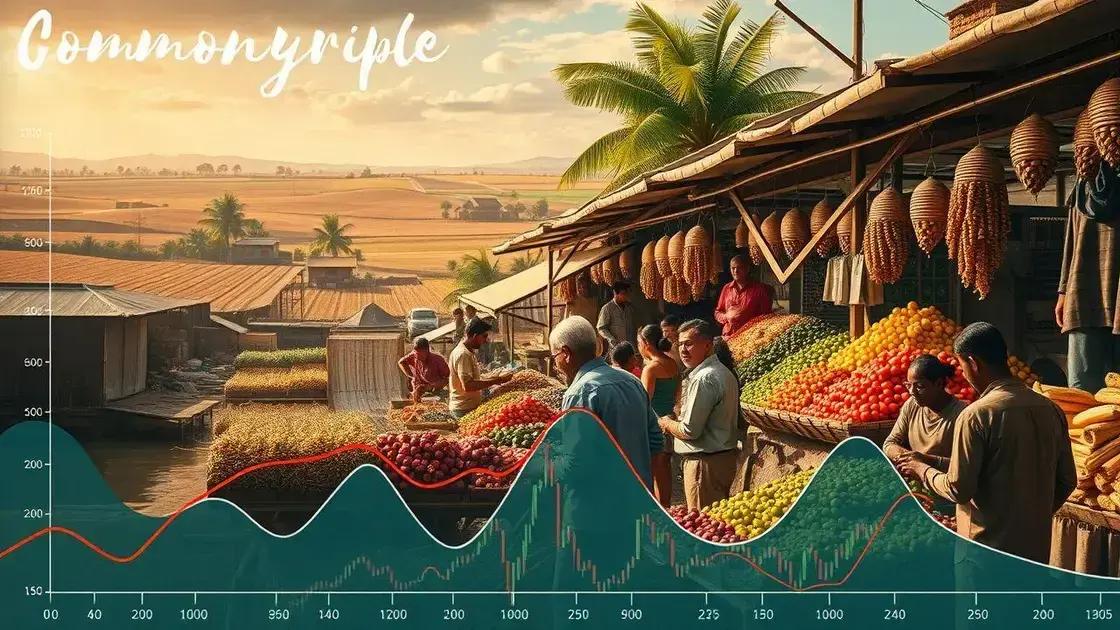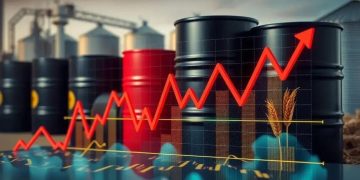Commodity price fluctuation analysis: what you need to know

Commodity price fluctuation analysis involves understanding the factors driving price changes, such as supply and demand, geopolitical events, and market speculation, to effectively manage risks and inform trading strategies.
Commodity price fluctuation analysis plays a crucial role in understanding economic trends. Have you wondered how these price changes affect daily life and global economies?
Understanding commodity price dynamics
Understanding commodity price dynamics is essential for anyone looking to grasp how markets work. Prices of commodities fluctuate based on various factors, impacting not only traders but also consumers and economies worldwide.
Several factors influence these price dynamics. Key among them are supply and demand, geopolitical events, and market speculation. Each of these elements plays a significant role in determining how prices rise or fall.
Supply and Demand
The most fundamental factor driving commodity price fluctuations is the balance between supply and demand. When demand exceeds supply, prices typically rise. Conversely, if supply outpaces demand, prices tend to drop. This relationship affects everything from oil to agricultural products.
Geopolitical Events
Geopolitical events can cause sudden and unpredictable shifts in commodity prices. Conflicts, trade agreements, or political instability in key producing regions can lead to supply disruptions. For instance, a conflict in an oil-producing country may cause global oil prices to surge.
- Political stability in producing countries can help stabilize prices.
- Trade agreements can lower tariffs, affecting prices positively.
- Natural disasters can impact supply chains and cause price spikes.
Market speculation also plays a vital role in how prices move. Traders often buy and sell based on predictions of future price movements, which can lead to volatility. When traders expect prices to rise, more buying occurs, pushing prices up, and vice versa.
By analyzing these factors, one can gain insight into commodity price dynamics. Knowing how external influences and market behaviors interact can lead to more informed trading decisions and a better understanding of the economic landscape.
Factors influencing price fluctuations

Factors influencing price fluctuations in commodities are critical to understanding market behavior. Each factor has a unique impact, reshaping how prices evolve over time.
One major factor is supply and demand. When demand rises for a particular commodity, prices generally increase. Conversely, if there is a surplus in supply, prices will likely drop. This basic principle affects many markets, from agricultural products to metals.
Economic Indicators
Economic indicators significantly sway commodity prices. Changes in economic growth rates, employment statistics, and consumer spending can lead to shifts in demand. Strong economic growth typically boosts demand, raising prices.
Natural Events
Natural events, such as droughts or hurricanes, can severely impact supply. Unexpected bad weather can damage crops, reducing availability and driving prices up. Conversely, a favorable growing season can lead to oversupply, lowering prices.
- Weather patterns play a large role in agricultural pricing.
- Natural disasters can disrupt logistics and availability.
- Seasonal trends affect supply and pricing cycles.
Market speculation cannot be overlooked in this context. Traders often react to news or forecasts, influencing prices even before physical changes in supply and demand occur. Speculative trading can create volatility, leading to surprising price changes.
Additionally, geopolitical tensions can lead to uncertainty in the markets. When conflicts arise in key regions, prices may spike due to fears of supply disruptions. Awareness of global political climates can provide insights into likely price movements.
Effects of price changes on global markets
The effects of price changes on global markets can ripple through economies, affecting consumers and industries alike. When commodity prices rise or fall, the implications can be far-reaching.
One of the most direct impacts of rising prices is inflation. As the cost of essential commodities, such as food and fuel, increases, consumers begin to feel the pinch in their wallets. Higher prices can lead to decreased purchasing power, impacting overall consumer spending.
Impact on Industries
Different industries respond uniquely to changes in commodity prices. For example, the agricultural sector may see costs rise as input prices for fertilizers and seeds increase. This change can ultimately lead to higher food prices for consumers.
Global Trade Flows
Shifts in commodity prices can also alter global trade flows. Countries that rely heavily on exporting certain commodities may experience economic shifts when prices drop. Export revenues can decrease, affecting national budgets and trade balances.
- Developing countries may face challenges in economic stability.
- Industries dependent on specific commodities can suffer layoffs.
- Currencies of exporting nations may weaken due to falling prices.
Furthermore, markets often react based on expectations of price changes rather than actual current prices. Speculators in financial markets buy and sell based on projections of future prices, creating additional volatility. This speculative trading can exacerbate price swings, leading to uncertain market conditions.
Understanding the effects of these price changes on global markets is crucial for policymakers, businesses, and consumers. By monitoring these shifts, stakeholders can make better-informed decisions, potentially mitigating adverse impacts on the economy.
Strategies for managing price volatility

Strategies for managing price volatility are essential for businesses and traders alike. Price swings can lead to uncertainty, making it crucial to have a plan in place.
One effective strategy is diversifying investments. By spreading investments across various commodities, businesses can reduce their risk. When one commodity’s price drops, others may hold steady or increase, balancing out potential losses.
Hedging
Another common approach is hedging. This involves using financial instruments, such as futures contracts, to protect against price decreases. By locking in prices, traders can mitigate losses and stabilize their revenue streams.
Staying Informed
Being aware of market trends is vital for managing volatility. Companies must regularly monitor news and reports about supply and demand, as well as geopolitical developments that can affect prices. Knowledge of these factors enables businesses to prepare for potential changes.
- Regular market analysis helps understand price movements.
- Setting alerts for significant price changes can facilitate quick responses.
- Networking with industry experts can provide valuable insights.
Moreover, developing flexible pricing strategies can be beneficial. Companies can adjust prices based on market conditions, allowing them to remain competitive while managing costs effectively. Such flexibility can help businesses thrive even during turbulent market periods.
Finally, having a contingency plan is crucial. Businesses should prepare for various scenarios involving price changes. This proactive approach enables them to respond swiftly to market fluctuations, ensuring sustainability and stability in their operations.
FAQ – Frequently Asked Questions about Commodity Price Fluctuation Analysis
What are commodity price fluctuations?
Commodity price fluctuations refer to the changes in prices of raw materials such as oil, metal, and agricultural products over time.
How do supply and demand affect commodity prices?
When demand exceeds supply, prices generally rise. Conversely, if supply is greater than demand, prices tend to fall.
What strategies can businesses use to manage price volatility?
Businesses can use strategies such as diversification of investments and hedging through futures contracts to mitigate risks associated with price volatility.
Why is it important to monitor market trends?
Monitoring market trends helps businesses anticipate price changes and make informed decisions to stay competitive and stable in the market.





